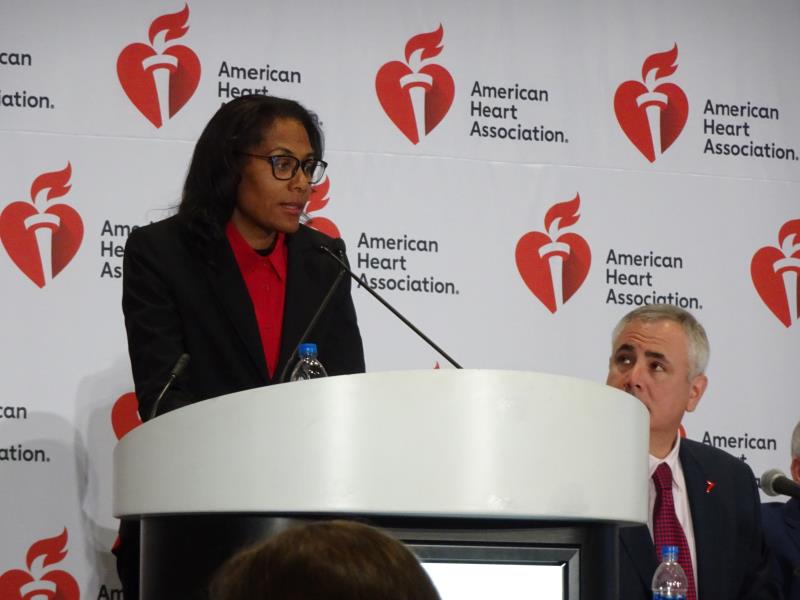 Prof R. Scott Wright
Prof R. Scott WrightTwice-a-year injections of the small interfering RNA (siRNA) inclisiran significantly reduced low-density lipoprotein cholesterol (LDL-C) levels in patients with atherosclerotic cardiovascular disease (ASCVD) who have insufficient LDL-C reductions despite maximum oral lipid-lowering therapy, the ORION-10* trial showed.
“ASCVD remains the leading cause of death globally. LDL-C lowering is the most effective intervention we have to change the course of ASCVD yet substantial residual risk persists despite aggressive treatment with statins and other agents including monoclonal antibodies to PCSK9**,” said Professor R. Scott Wright from the Mayo Clinic, Rochester, Minnesota, US, who presented the findings at AHA 2019.
“Inclisiran achieved durable and potent reductions in LDL-C using essentially a twice-yearly injection in patients with ASCVD who are already on appropriate aggressive lipid-lowering therapies over 18 months of follow-up with a safety profile similar to placebo in this high-risk CV population. Inclisiran therefore potentially offers a novel new treatment for LDL-C,” he said.
A total of 1,561 adults with ASCVD (LDL-C ≥70 mg/dL; baseline LDL-C 105 mg/dL) despite maximum tolerated doses of statins (or intolerance) were randomized to receive subcutaneous injections of inclisiran (300 mg; n=781; median age 67 years, 69 percent male) or placebo (n=780; median age 66 years, 70 percent male) on days 1, 90, 270, and 450 of the trial. Ten and nine percent of inclisiran and placebo recipients, respectively, also received ezetimibe. Seventy-seven and 79 percent of inclisiran and placebo recipients, respectively, were on high-intensity statin therapy.
At day 510, patients who received inclisiran experienced a 58 percent reduction in LDL-C levels compared with those who received placebo (mean percentage change, -56 percent vs 1 percent; p<0.00001). [AHA 2019, LBA 1]
A 56 percent reduction in LDL-C levels with inclisiran over placebo was sustained over days 90–540 (mean percent change, -53 percent vs 3 percent; p<0.00001).
Treatment-emergent adverse events (TEAEs) occurred at a comparable rate between inclisiran and placebo recipients (74 percent vs 75 percent), specifically diabetes mellitus-related AEs (15 percent vs 14 percent), hypertension (5 percent each), upper respiratory tract infection (5 percent each), bronchitis (6 percent vs 4 percent), and dyspnoea (5 percent vs 4 percent). Protocol-defined TEAEs such as erythema, rash, reactions, pruritus, and hypersensitivity, occurred more frequently in inclisiran than placebo recipients (2.6 percent vs 0.9 percent), though these were mostly mild (1.7 percent vs 0.9 percent). More inclisiran than placebo recipients experienced injection-site reactions, in the first two injection cycles (vial + syringe; 2.1 percent vs 0.4 percent) and in cycles 3 and 4 (pre-filled syringe; 1.0 percent vs 0.1 percent).
There was no evidence of kidney, liver, muscle, or platelet toxicity, with AE incidence comparable between treatment groups. A creatinine increase of >2 mg/dL occurred in 3.9 percent of patients in each group. Serious TEAEs also occurred at a similar rate between inclisiran and placebo recipients (22.4 percent vs 26.3 percent), specifically, worsening or recurrent malignancy (3.3 percent in each group), and TEAE-related drug discontinuation (2.4 percent vs 2.2 percent). The pre-specified CV endpoint comprising cardiac death, signs or symptoms of cardiac arrest, and non-fatal myocardial infarction and/or stroke occurred in a smaller proportion of inclisiran than placebo recipients (7.4 percent vs 10.2 percent).
“Inclisiran potently and durably reduced LDL-C by 58 percent at day 510 and 56 percent using a time-averaged value from days 90–540. This was done with a safety profile comparable to placebo with no adverse changes in laboratory markers, with a low rate of injection-site reactions, and with numerically fewer MACE*** in the inclisiran group compared to placebo,” Wright summarized.
Questions remain
“We know that the LDL reduction was impressive,” said discussant Professor Karol Watson from the David Geffen School of Medicine at the University of California, Los Angeles (UCLA), California, US. Nonetheless, certain aspects of inclisiran are yet undetermined.
The effect of inclisiran on other lipid parameters – such as high-density lipoprotein cholesterol (HDL-C), triglycerides, and lipoprotein(a) – remains to be seen. Seeing as inclisiran would be “theoretically, a lifelong therapy,” the safety and efficacy of the treatment over a longer-term period also need to be established.
“We also don’t know if there were any important inter-individual differences in inclisiran response … or the impact of infrequent dosing on patient adherence … [or] if treatment with inclisiran will lead to improved clinical outcomes over the long-term above and beyond what we’ve seen with statins,” she noted.
Additionally, the 58 percent reduction in LDL-C with inclisiran, as noted in this study, will be achieved by some patients with statins.
Where we are and where we’re headed
“What we’re getting to is the idea that the lower we push LDL, the better the clinical outcomes will be,” noted Watson. “The long-term benefits of LDL-lowering therapy require that patients stay on therapy – it requires us to get the LDL low and keep it low.”
“Inclisiran is the first cholesterol-lowering agent in the siRNA class, opening up new and exciting possibilities,” she added. “Increasing the number and types of effective therapeutic options available will be good for our patients.”
“[However], the effectiveness of statins and other cholesterol-lowering agents absolutely relies on patients taking them correctly and consistently … finding medications that are both effective and that can enhance patient adherence will improve outcomes,” said Watson.
 Prof Karol Watson
Prof Karol Watson